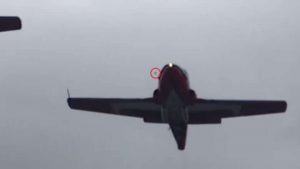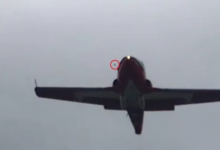Bird strike blamed in fatal crash of Canadian military Snowbird jet

A bird strike, causing an engine compressor failure, has been formally declared as the cause of last year’s fatal crash of a Canadian military Snowbird demonstration jet in Kamloops, B.C.
Snowbird investigation focusing on possible bird strike before fatal crash
The Royal Canadian Air Force’s Directorate of Flight Safety released its final report Monday into the accident, which took place on May 17, and killed Capt. Jenn Casey, the public affairs officer for the aerobatics team.
The investigation found that a single, small bird was sucked into the engine of the aircraft – Snowbird 11 – following take-off.
That resulted in a compressor stall and a loss of thrust as the aircraft was trying to climb.

Upon loss of power, the pilot, Capt. Richard MacDougall, tried to turn back towards the airport and during the maneuver “the aircraft entered an aerodynamic stall and the pilot gave the order to abandon the aircraft,” the military said in a statement.
“Snowbird 11’s power loss could not have come at a worse time – low altitude, low airspeed, proximity to another aircraft, and in the vicinity of a built-up area,” said Col. John Alexander, the Air Force’s director of flight safety.
Emergency training needed
The tragic accident “reinforces the importance of continuous, situation-specific training to minimize reaction time in an emergency and the importance of a timely decision to eject,” he added.
In a preliminary report issued in June of last year, investigators said video footage from the crash showed a bird was very close to the right-side air intake of the aircraft’s single engine during takeoff. It’s possible the bird struck the air intake, the report suggested.
Such strikes are not uncommon. As a matter of routine, flight planners are expected to take careful precautions against bird strikes, especially during migratory season.
Video of the crash taken by an eyewitness shows, as the jet was climbing, a small bird unexpectedly appeared in front of the jet and was sucked into the air intake of the right engine.
The aircraft turned and went into a steep nose dive before hitting the ground in a residential neighbourhood.
The final report said MacDougall and Casey, originally from Nova Scotia, were ejected from the aircraft “at low altitude and in conditions that were outside safe ejection seat operation parameters.”

Neither of them had the time for their parachutes to function.
The jet was destroyed on impact.
MacDougall was injured and has recovered.
The flight safety report recommends additional training for CT-114 aircrew to better prepare them for an engine failure after take-off in a low-level environment.
It also recommends changes to the ejection procedure.








Redes Sociais - Comentários